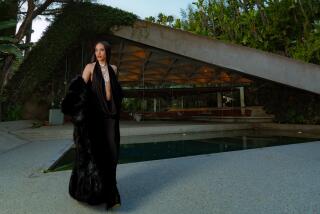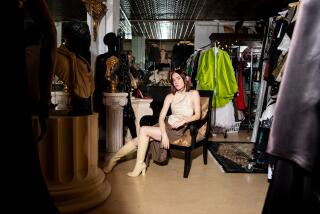New cars, classic mood
- Share via
Las Vegas — J Mays is driving a brand new red convertible Thunderbird with the top down. It’s a beautiful day, the traffic on the Strip is unusually light, and he’s smiling, snug in the bucket seat, knees just above the bottom of the steering wheel, one hand steering, the other resting on the bright red gearshift. Short cropped hair, Brioni suit, black mock-turtleneck. Very cool.
A young woman pulls up beside him, rolls down her window and asks how much the car sells for. Automatically, clearly used to such questions, he tells her, “$35,000 list,” and when she says, “Good-looking car,” he smiles and quite genuinely responds, “Well, thank you.” For no apparent reason, as he speaks she looks sharply at him and asks, “Did you design it?” Mays tips his head slightly, clearly taken aback by the question in this anonymous setting, and responds, “Yes, I did.”
For the record:
12:00 a.m. Nov. 20, 2002 For The Record
Los Angeles Times Wednesday November 20, 2002 Home Edition Main News Part A Page 2 ..CF: Y 12 inches; 448 words Type of Material: Correction
Chevrolet Caprice -- An article in Sunday’s Calendar section about Ford Motor Co. design director J Mays included a quote from Mays referring to a 1963 Caprice owned by his family when he was a child. In fact, Chevrolet, the manufacturer of the Caprice, did not produce that car until 1965. Mays misspoke -- his family’s car at the time was a Chevrolet Impala.
For The Record
Los Angeles Times Sunday November 24, 2002 Home Edition Sunday Calendar Part E Page 2 Calendar Desk 1 inches; 63 words Type of Material: Correction
Chevrolet Caprice -- An article in last Sunday’s Calendar about Ford Motor Co. design director J Mays included a quote from Mays referring to a 1963 Caprice owned by his family when he was a child. In fact, Chevrolet, the manufacturer of the Caprice, did not produce that car until 1965. Mays misspoke -- his family’s car at the time was a Chevrolet Impala.
How did she know? Was she for real? Las Vegas, with all its false facades, layered realities and incongruous juxtapositions, seems the perfect setting for such a Memorex moment. And Mays, vice president for global design at Ford Motor Co., who’s in town briefly for a show of specialty automotive equipment, has become best known for re-designing such classics as the T-Bird. He may just be the perfect subject for such a question -- which really is not as simple as it sounds.
Yes, he did design it. And, well, no, he didn’t.
Mays is the hands-on director of the design team that created the new Thunderbird, which is based on the 1950s and ‘60s Thunderbirds but isn’t really the same at all. It’s updated, refined, spiffier and very 2000s, as authentic a new car as the Venetian Hotel (which he’s just passed) is an authentic new hotel, and as different from an original T-Bird as the Venetian is from Venice. Which is what life appears to be all about these days. The new is about the old, looking forward means looking back -- from the techno-reissues of classic pop singles to the appropriations of artists like Sherry Levine, who has photographed other photographers’ work, or Kenny Scharf, who has incorporated familiar cartoon figures in his paintings, to the feel-good comeback of hippie fashion. Still, it takes a visionary to make the new into more than the old in a way that is just right for today.
“Retrofuturism: The Car Design of J Mays” opens today at the Geffen Contemporary at L.A.’s Museum of Contemporary Art. Organized by Brooke Hodge, MOCA’s architecture and design curator, this is, she says, the first museum exhibition to be devoted to the work of a single American car designer. The question of how automotive design fits into a larger cultural context seems particularly relevant at a museum like MOCA, which in one of its first shows, in 1984, presented “Automobile and Culture,” an examination of the overlap between cars and art.
Likewise, Mays, who sees the world as a palette for his designs, is comfortable skipping from discussions of Las Vegas to art, movies, rap music and fashion, despite the fact that he sees his own work as fundamentally linked to the classical geometry of Modernism.
Exploratory gestures
Mays’ philosophy is that every good design elicits an emotional response. Much like a movie, he says, a car takes your imagination to places you haven’t been for a while, or have never been. “You don’t actually lay the entire story out,” he says, “but you put just enough clues in the design of the vehicle that the customer can connect the rest of the dots in their mind.”
At 48, Mays seems both wise and unimpressed with himself, comfortable making grand statements and yet not ready to give up his involvement in the minutiae of creating new products. Both very urban and also decidedly rooted in middle America, he was born and raised in Maysville, Okla., a town just south of Oklahoma City that’s named for his family and that, at the time of his childhood, had a population of 800. The single-initial (no period) first name, he laughs, is not an affectation, but the result of unimaginative naming practices in his family. “Like J.R. Ewing,” he says.
After studying journalism at the University of Oklahoma, Mays skipped out to Pasadena’s Art Center College of Design to study car design. It was the late 1970s, and he quickly stood out for his conservatism. “He was more focused than everyone else,” remembers Richard Pietruska, an instructor in the transportation department. “He was pretty clean-cut and was more interested in designing an aerodynamic look, when the other students were interested in radical styling.”
Upon graduating in 1980, Mays moved to Germany to work for Audi AG, where he designed the Avus Quattro concept vehicle, a sleek sports car that eventually evolved into the Audi TT. He broke into the big time, however, when he returned to the United States for Volkswagen and, in collaboration with Freeman Thomas, developed the prototype for the new Beetle, revealed in 1994 as Concept One.
Three years later, Mays became the global design master at Ford, based in Detroit, where he oversees all eight divisions: the classic Blue Oval (as they call it in Michigan), Lincoln, Mercury, Mazda, Volvo, Jaguar, Land Rover and Aston Martin.
At Ford, he has developed the GT40 and the 2002 Thunderbird, among others. His concept vehicles, which are highlighted at MOCA, include the Ford Forty-Nine, the 021C (developed with hip product designer Marc Newson) and the Ma, to be unveiled for the first time in the exhibition. The latter is a modern hot rod, created as a kit to be assembled by the customer, with bamboo hood and seats and an aluminum frame. It was designed by Jose Paris, under Mays’ supervision, and Mays says it will more than likely remain just a concept.
“J is extraordinary for his exploratory gestures,” says Richard Koshalek, president of Art Center. “He is exceptional in the way that he combines car and product design.”
Not simply a Retrofuturist, Mays spans a wide range of interests in his designs. The Audi Avus Quattro is a fantasy of a sleek, high-end racer, while the Beetle embodies the practical simplicity of its predecessor, reduced to simpler geometry that, turned upside-down, looks like either a classic smiley face or Mickey Mouse, a fact that has not escaped its creator. The same simple functionality is echoed in the boxy Ford 021C, named for an orange Pantone color. A lust for Ford’s glory days inspired the Forty-Nine, an extreme simplification of the lumbering 1949 homeboy car that inspired it. But for pure romance, there’s nothing like the Thunderbird.
Mays’ own connection to the mystique of the Thunderbird is direct. “It was 1965,” he says, smiling at the memory. “I was 10 years old, and my brother was 17. My dad had to trade in the ’63 Caprice that we had, and he wanted to get a new family sedan. He disappeared off down to the Ford dealership, where he had seen a Galaxy he wanted to purchase. He was going to be back in an hour or two.
“Well, an hour went by, two hours went by, three hours went by, and the sun started going down, and he still wasn’t back. And finally, just before the sun set -- we lived up on a hill, and you could see down onto the road below our home -- we saw this turquoise Thunderbird coming toward the house, and my brother and I were just jumping around like madmen going, ‘Dad bought the Bird! Dad bought the Bird!’ It was just a huge big family emotional event. We weren’t wealthy, and Thunderbirds weren’t that expensive, but it just said, ‘This is a typical middle-class family having the good life.’ ”
A yearning to recapture that magic is at the heart of Retrofuturism, a movement that has developed over the past two decades in art and commerce in response to the global death of optimism, Mays and others believe. Where once the future looked bright -- in the 1950s and ‘60s -- the image of that future remained fixed on the year 2000. “With every year, the future became nearer. It had a number on it,” Mays says. “So the unfortunate eventuality is, we’ve gotten to the future, and it isn’t what we expected. I think we’re a bit scared of the future at this point.”
Evoking mid-20th century design conjures up the thrill of that turquoise T-Bird coming up the hill. “It’s a safety blanket of sorts,” Mays admits, “a longing on the part of people who want to hold onto something that makes them feel pretty good.”
Degas and dashboards
As he drives the T-Bird through the bright streets of Las Vegas, Mays talks about how a show of paintings by Degas at the Detroit Art Institute made him realize how far he needs to go to improve the palette of car interiors. How the light in the 19th century Impressionist’s paintings helped codify his vision of how color can affect how we feel in a car.
He may be designing for the fast lane, but he takes time to notice the details and to see what he can learn. Even from artifacts that were made to be taken in in very slow motion.
And when he wants to see the real future, he has to look no farther than his 9-year-old son. Mays says the boy regularly rolls his eyes and tells him, “Oh, Dad, you don’t have any style.” The designer’s response is pretty typical of a dad facing middle age. “You know,” he says, “I look at my wife, and she says, ‘He’s right, you know.’ And he is.”
Professionally, the eye-rolling is a challenge, because Mays and his team are working on cars that may not emerge for another six or seven years -- cars, he points out, that his son will be driving someday. But perhaps Mays’ mix of self-deprecation and clarity of vision is what has allowed him to make work that bows as it borrows from eras past, even as it somewhat arrogantly attempts to make the already-made even better.
*
‘Retrofuturism’
What: “Retrofuturism: The Car Design of J Mays”
Where: Geffen Contemporary,
152 N. Central Ave., L.A.
When: Today through March 9. Open Tuesdays-Sundays, 11 a.m.-5 p.m.; Thursdays, 11-a.m.- 8 p.m.
Price: $8, adults; $5, students and seniors; children, free.
Contact: (213) 626-6222






